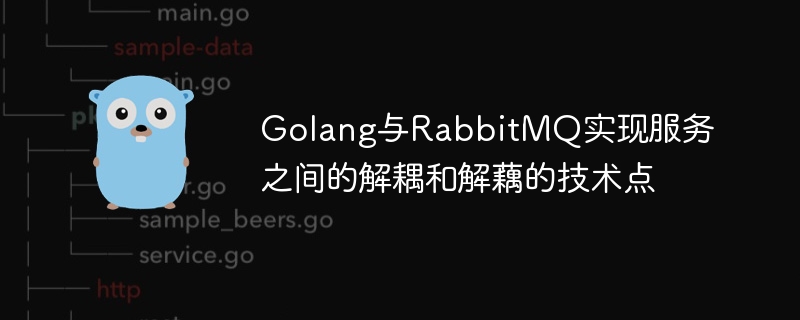

The technical points of decoupling and decoupling between Golang and RabbitMQ require specific code examples
Overview:
In modern distribution In traditional systems, decoupling and decoupling between services is very important. To achieve this goal, we can use Golang and RabbitMQ to build a reliable and high-performance message queue system. This article will introduce how to use Golang and RabbitMQ to achieve decoupling and decoupling between services, and provide corresponding code examples.
Technical Point 1: Using RabbitMQ for message delivery
RabbitMQ is a powerful open source message queuing system that implements the AMQP (Advanced Message Queuing Protocol) protocol. It can be used as middleware between services, ensuring reliable delivery of messages and providing high throughput and low latency performance.
In Golang, we can use RabbitMQ's official client library streadway/amqp to produce and consume messages. The following is a sample code using RabbitMQ for messaging:
package main
import (
"fmt"
"log"
"os"
"github.com/streadway/amqp"
)
func main() {
// 创建连接
conn, err := amqp.Dial("amqp://guest:guest@localhost:5672/")
if err != nil {
log.Fatal(err)
}
defer conn.Close()
// 创建通道
ch, err := conn.Channel()
if err != nil {
log.Fatal(err)
}
defer ch.Close()
// 声明队列
q, err := ch.QueueDeclare(
"hello", // 队列名称
false, // 是否持久化
false, // 是否自动删除
false, // 是否独占
false, // 是否等待服务器响应
nil, // 其他参数
)
if err != nil {
log.Fatal(err)
}
// 发布消息
body := "Hello, RabbitMQ!"
err = ch.Publish(
"", // exchange名称
q.Name, // routing key
false, // mandatory:是否需要确认
false, // immediate:是否立即发送
amqp.Publishing{
ContentType: "text/plain",
Body: []byte(body),
},
)
if err != nil {
log.Fatal(err)
}
fmt.Println("消息已发送")
}Technical point 2: Using Golang to implement consumers
In Golang, we can use RabbitMQ’s official client library streadway/amqp to write consumer code. The following is a sample code that uses Golang to implement a RabbitMQ consumer:
package main
import (
"fmt"
"log"
"github.com/streadway/amqp"
)
func main() {
// 创建连接
conn, err := amqp.Dial("amqp://guest:guest@localhost:5672/")
if err != nil {
log.Fatal(err)
}
defer conn.Close()
// 创建通道
ch, err := conn.Channel()
if err != nil {
log.Fatal(err)
}
defer ch.Close()
// 声明队列
q, err := ch.QueueDeclare(
"hello", // 队列名称
false, // 是否持久化
false, // 是否自动删除
false, // 是否独占
false, // 是否等待服务器响应
nil, // 其他参数
)
if err != nil {
log.Fatal(err)
}
// 消费消息
msgs, err := ch.Consume(
q.Name, // 队列名称
"", // consumer标签
true, // auto-ack:是否自动确认
false, // exclusive:是否独占
false, // no-local:是否禁止本地消费
false, // no-wait:是否等待服务器响应
nil, // 其他参数
)
if err != nil {
log.Fatal(err)
}
// 处理消息
for msg := range msgs {
fmt.Printf("收到消息:%s
", msg.Body)
}
}Conclusion:
By using Golang and RabbitMQ, we can achieve decoupling and decoupling between services. Message queues provide asynchronous communication capabilities and can decouple services, thereby improving the scalability and maintainability of the system. Using the code examples above, you can start building reliable and performant distributed systems. Hope this article is helpful to you.
The above is the detailed content of Golang and RabbitMQ realize the technical points of decoupling and decoupling between services. For more information, please follow other related articles on the PHP Chinese website!
 How to use digital currency
How to use digital currency
 what is okx
what is okx
 Software testing tools
Software testing tools
 How to change ip address in linux
How to change ip address in linux
 What are the advantages of the Spring Boot framework?
What are the advantages of the Spring Boot framework?
 What are the spring frameworks?
What are the spring frameworks?
 How to use plot function in Python
How to use plot function in Python
 Introduction to the main work content of front-end engineers
Introduction to the main work content of front-end engineers
 What is the shortcut key for brush size?
What is the shortcut key for brush size?




